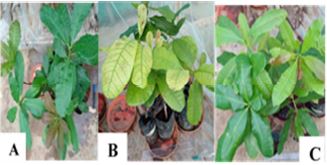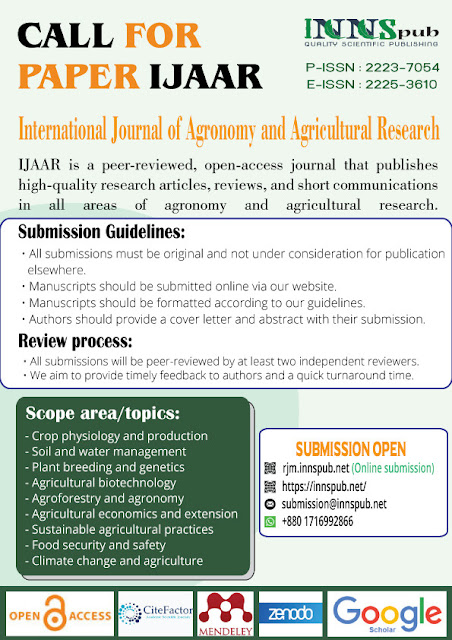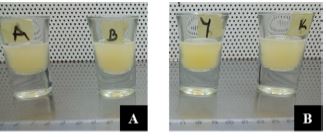Tehua Amoa Armist, Kouman Abenan Manou Natacha, Koffi Yao Fulgence, Alloue-Boraud Waze Aimée Mireille, and et Kone Daouda, from the different institute of the Côte d’Ivoire. wrote a research article about, Microbial Biopesticides: Controlling Xanthomonas citri in Cashew. entitled, Efficacy of Microbial Biopesticide Formulations in the control of Xanthomonas citri pv. Mangiferaeindicae in Cashew (Anacardium occidentale L.) in Cote D’ivoire. This research paper published by the International Journal of Agronomy and Agricultural Research (IJAAR). an open access scholarly research journal on Agronomy, under the affiliation of the International Network For Natural Sciences | INNSpub. an open access multidisciplinary research journal publisher.
Abstract
The cashew tree (Anacardium
occidentale L.) occupies an important place in the world because of its
cashew nut. However, its cultivation is confronted with bacteriosis, a
bacterial disease caused by Xanthomonas citri pv. Mangiferaeindicae.
This disease is one of the main causes of the low yield per hectare of cashew
nuts, which fluctuates between 350 and 500 kg/ha. In view of this, it is wise
to find ways of controlling this disease. It is in this context the objective
of this work was to produce bio-formulations based on bacteria isolated from
the rhizosphere of cashew trees, in order to evaluate their effectiveness on
the growth of the agent responsible for cashew bacteriosis (Xanthomonas citri pv. Mangiferaeindicae).Thus,
two liquid formulations were made from Pseudomonas fluorescens and Bacillus subtilis isolated
from the rhizosphere of cashew. Stability, in vitro antagonism and
biocontrol tests against Xanthomonas citri pv. Mangiferaeindicae were
performed. The results obtained showed an inhibition of the Xanthomonas
citri pv. Mangiferaeindicae bacterium with inhibition zones of
8.13 ± 2.1 and 25.20 ± 3.9 mm in diameter respectively for the products
formulated with Bacillus subtilis and Pseudomonas fluorescens.
In biocontrol tests, both formulated products showed their ability to protect
cashew plants against bacterial blight with reduction rates of 80.95 ± 2.3 %
and 73.80 ± 5.2% for the Pseudomonas fluorescens and Bacillus subtilis formulations,
respectively. These two formulations of bacterial, once tested in cashew
plantations, could be used in the biological control of cashew bacterial blight
in Côte d’Ivoire.
Read more : Probiotic Potential:Screening Lactobacillus acidophilus in Bangladesh | InformativeBD
Introduction
Food security is defined as access to safe and sufficient food for all. Meeting the food demand of a rapidly growing world population is becoming a major challenge for humanity. To meet the food needs of the population, agricultural productivity will have to be increased in a sustainable manner worldwide (Kumar et al., 2012). However, insect pests and plant pathogens (fungi, bacteria or viruses) contribute to the decline in agricultural productivity, which can be as high as 70%. Indeed, plants as well as harvested and stored products are subjected to attacks by many pathogens (Popp et al., 2013). This is the case for cashew (Anacardium occidentale L.) in Côte d'Ivoire.Cashew, a crop that plays an important role in the Ivorian economy because of its cashew nut, is a particular strategic and income-generating resource for farmers in the North, South, Centre and East of the country (Soro, 2012). However, despite the economic and nutritional importance of cashew, its cultivation is subjected to several phytopathological problems that compromise the quality and quantity of cashew yield (Silué et al., 2017). Bacterial blight is a bacterial disease of cashew caused by Xanthomonas citri pv. Mangiferaeindicae. This disease manifests itself by oily angular spots on the leaves surrounded or not by a halo-chlorotic. It attacks all the vital organs of the plant with high severity (Zombre et al., 2017). In Benin, a work of Afouda et al. (2013) revealed average severities of 32.96%. This high severity of bacterial blight could lead to a decrease in cashew nut yield. Also, Soro et al. (2017) found evidence of bacterial blight in cashew orchards in Côte d'Ivoire with relative incidences of 15%. To control this disease, producers resort to the use of chemical pesticides (Camara et al., 2015).
This strategy can be effective, but the repeated use of these chemicals generates harmful consequences for the environment and the health of the user. Indeed, these products favour the resistance mechanism in pathogens and the ecological imbalance due to the broad spectrum of action of most synthetic compounds. This would lead to the destruction of pests, but also of other populations in the ecosystem and can also cause serious health problems due to pesticide residues in foodstuffs (Kouassi, 2012). In order to mitigate the adverse effects of chemical pesticides, biological control agents are emerging as promising alternatives for the management of crop pathogens. Among these biological agents, microbial biopesticides (bacteria, fungi, viruses) are the most appropriate. Indeed, they offer advantages of higher selectivity and lower toxicity compared to conventional chemical pesticides (MacGregor et al., 2006). Recent studies have shown their importance in disease biocontrol (Pérez-Garcia et al., 2011). However, the formulation of microbial biopesticides is a key element in the design of control strategies for plant and crop diseases caused by plant pathogens (Nam et al., 2018).
During this decade, numerous works in greenhouse and field trials have shown the potential value of rhizosphere bacteria, including Pseudomonas fluorescens and Bacillus subtilis as biological control agents for plant pathogens (Akram, 2008). A work of Koua (2020) showed that B. subtilis strains isolated from the rhizosphere of cocoa trees in Côte d'Ivoire would be effective bioinoculants in the control of cocoa diseases in greenhouses such as swollen shoot. It would therefore be interesting to find a stable bacterial biopesticide formulation suitable for the control of bacterial diseases of cashew trees and thus find a sustainable solution to the problem posed by synthetic products in Côte d'Ivoire. The general objective of this work is to evaluate the efficacy of a formulation of bacterial biocontrol agents based on bacteria (P. fluorescens and Bacillus subtilis) isolated from the rhizosphere of cashew trees against Xanthomonas citri pv. Mangiferaeindicae.
Reference
Afouda LCA, Zinsou V,
Balogoun RK, Onzo A, Ahohuendo BC. 2013. Inventaire des agents pathogènes
de l’anacardier (Anacardium occidentale L.) au Bénin, Bulletin de la
Recherche Agronomique du Bénin (BRAB) (73), ISSN sur papier (on hard
copy): 1025-2355 et ISSN en ligne (on line) : 1840-7099
Akram A. 2008.
Elicitation de la résistance systémique induite chez la tomate et le concombre
et activation de la voie de la lipoxygénase par des rhizobactéries
non-pathogènes. Thèse de Doctorat, Université de Liège, Belgique. 169 p
Alvarez-Solano O. 2006.
Thèse de doctorat, Emulsion inverses très concentrées : influence du procédé et
de la formulation sur leurs propriétés rhéologiques, Université de lorraine.
166p
Aridity S. 2004.
Thèse de doctorat, Fabrication, stabilité et propriétés rhéologiques des
émulsions stabilisées par des particules colloïdales, Université Bordeaux I.
14-16.
Cabrefiga J, Francés J,
Montesinos E, Bonaterra A. 2014. Improvement of a dry formulation of Pseudomonas
fluorescens EPS62e for fire blight disease biocontrol by combination of
culture osmo adaptation with a freeze-drying lyoprotectant. Journal of Applied
Microbiology 117, 1122-1131
Camara B, Daouda K,
Mauricette S O, Mamadou C. 2015. Maladies et insectes ravageurs de
l’anacardier. Livret carte sanitaire anacardier 9 P.
Cardosso JE, Santos AA,
Rossetti AG, Vidal JC. 2004. Relationship between incidence and severity
of cashew gummosis in semiarid north-eastern Brazil. Plant Pathology 53(3), 363-367
Fatima Z, Saleemi M,
Zia M, Sultan T, Aslam M, Chaudhary M F. 2009. Antifungal activity of
plant growth-promoting rhizobacteria isolates against Rhizoctonia solani in
wheat. African Journal of Biotechnology 8, 219-225
Groth JV, Ozmon E A,
Busch R H. 1999. Respeatability and relationship of incidence and severity
measures of scab of wheat caused by Fusarium graminearum in inoculated
nurseries. Plant Disease 83, 1033-1038
Kumar Mishra V, Kumar
A. 2012. Plant growth promoting and phytostimulatory potential of Bacillus
subtilis and Bacillus amyloliquefaciens. Agricultural and biological
sciences 7(7), 509-519
McGregor CH, Wolff J A,
Arora S K, Hylemon P B, Phibbs P V. 1992. Catabolite repression control
in Pseudomonas aeruginosa. In: Pseudomonas, Molecular Biology and
Biotechnology (E Galli, S Silver, B Witholt, eds), Am Soc Microbiol,
Washington, DC pp. 198-207
Mensah A, El Aissaoui
A, El Yousfi B. 2017. Etude de biopesticides à base d’ortie (Urtica dioica L.):
Rhéologie d’application et test du pouvoir fongicide. Revue Marocaine de
Protection des Plantes 11, 41-53
Moral J, Trapero
A. 2009. Assessing the susceptibility of olive cultivars to anthracnose
caused by Colletotrichum acutatum. Plant Disease 93, 1028-1036
Nguefack J, Somda I,
Mortensen CNAZP. 2005. No Title Evaluation of five essential oils from
aromatic plants of Cameroon for controlling seed-borne bacteria of rice (Oyzae
sativa L.). Seed Science and Technology 33, 397-407
Pérez-García A, Romero
D, Vicente A D. 2011. Plant protection and growth stimulation by
microorganisms: Biotechnological applications of Bacilli in agriculture.
Current Opinion Biotechnology 22(2), 187-193
Popp J, Petö K, Nagy
J. 2013. Pesticide productivity and food security. A review. Agron.
Sustainable Dev 33, 243-255
Showkat S, Murtaza I,
Laila O, Ali A. 2012. Biological Control of Fusarium oxysporum and Aspergillus sp.
by Pseudomonas fluorescens isolated from wheat rhizosphere soil
of Kashmir. IOSR Journal of Pharmacy and Biological Sciences 1, 24-32
Silue N, Soro S, Koné
M, Daouda K. 2017. Parasitical fungi in cashew (Anacardium occidentale L.)
Orchard of Côte d’Ivoire. Plant Pathol. J. 16, 82-88
Soro D. 2012.
Couplage de procédés membranaires pour la clarification et la concentration du
jus de pomme de cajou : performances et impacts sur la qualité des produits.
Thèse de doctorat : Sciences des Procédés-Sciences des Aliments.
Montpellier SUPAGRO : Institut des régions chaudes. 156 P
Soro S, Silué N,
Ouattara G M, Chérif M, Camara B, Sorho F, Abo K, Koné M, Kouadio Y J, Koné
D. 2017. Intensification agro-écologique de la production et de la
transformation du cajou en Afrique : Acquis scientifiques et
technologiques- Perspectives, Colloque International d’échanges scientifiques
sur l’anacarde (CIESA), 26-28 Octobre, Bassam, Côte d’Ivoire, pp 138-142
Thakore Y. 2006.
The biopesticide market for global agricultural use. Industrial
Biotechnology 2(3), 294-208.
Toty AA, Guessennd N,
Bahi C, Kra AM, Otokore DA, Dosso M. 2013. Évaluation in-vitro de
l’activité antibactérienne de l’extrait aqueux de l’écorce de tronc de Harungana
madagascariensis sur la croissance de souches multi-résistantes. Bulletin
de la Société Royale des Sciences de Liège (82), 12-21
Wojcieh J J, Lise
K. 2002. Biological control of postharvest diseases of fruits. Annu. Rev.
Phytopatol. 40, 411-441
Zombré C, Sankara P,
Ouedraogo S L, Wonni I, Boyer K, Boyer C, Terville M, Javegny S, Allibert A,
Vernière C, Pruvost O. 2016. Natural infection of cashew (Anacardium
occidentale) by Xanthomonas citri pv. Mangiferaeindicae in
Burkina Faso. Plant Disease 100, 718-723












%20in%20full.JPG)


0 comments:
Post a Comment